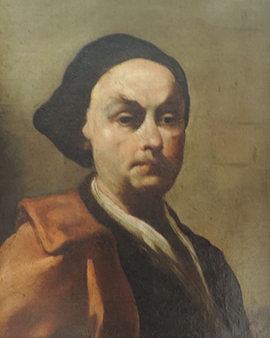Wrapped in the garb of the Baroque, Giuseppe Maria Crespi began his artistic journey as a traditional painter of Italy. But like a butterfly emerging from its cocoon, Crespi broke out of the shackles of academic tradition and developed a style that was far ahead of its time. With artists such as Giambattista Pittoni, Giovanni Battista Tiepolo, Giovanni Battista Piazzetta, Canaletto and Francesco Guardi, he shared the honor of being counted among the Old Masters of his era. Crespi, also known as "Lo Spagnuolo" because of his Spanish fashion style, stood out for his versatility - he created both religious subjects and portraits, but today he is most famous for his genre paintings.
Born in Bologna, Crespi became one of the figureheads of the Bolognese school. He entered Angelo Michele Toni's apprenticeship at the age of 12 and completed his training at Domenico Maria Canuti and later at Carlo Cignani's studio. After Cignani's departure from Bologna, Crespi found his independence and began to run his own studio. Although his early works were strongly influenced by the High Baroque classicism of his teachers, he revolutionized his art by traveling to Venice and other northern Italian cities. Here he took a liking to the flowing style of the early Baroque and developed his own interpretation of this art movement. However, he showed little interest in the Roman art scene and even declined an invitation from the Roman painter Carlo Maratta to visit him in Rome.
Among Crespi's most famous works, the painting "The Flea Seekers" stands out, a typical representation of his genre, capturing the simple and poor people in their everyday life. Despite his unconventionality and capriciousness, which brought him criticism from artists such as the Italian-based German painter Anton Raphael Mengs, Crespi was a sought-after teacher. His studio attracted artists such as Antonio Gionima and Giovanni Battista Tiepolo0, and he was a major influence on the Venetians Giovanni Battista Piazzetta and Giovanni Battista Tiepolo2.
After the death of his wife, Crespi withdrew from the public eye and spent his days in silent prayer before dying at the age of 82. But although the artist has passed, his works live on and are available today as fine art prints, reproduced with the highest quality and care to do justice to Crespi's legacy. Through these art prints we contribute to preserve the artistic legacy of this extraordinary artist and keep the spirit of his art alive in today's world.
×





.jpg)
.jpg)
.jpg)
.jpg)
.jpg)
.jpg)
.jpg)
.jpg)
.jpg)
.jpg)
_1700-171_-_(MeisterDrucke-947713).jpg)
_1700-171_-_(MeisterDrucke-947713).jpg)
_Crespi_-_La_mort_de_saint_Joseph_(Death_of_Saint_Joseph)_Vieillard_allonge_sur_son_lit_de_-_(MeisterDrucke-1318209).jpg)
_Crespi_-_La_mort_de_saint_Joseph_(Death_of_Saint_Joseph)_Vieillard_allonge_sur_son_lit_de_-_(MeisterDrucke-1318209).jpg)
_Crespi_-_The_Kitchen_Girl_Painting_by_Giuseppe_Maria_Crespi_said_lo_Spagnolo_(Spanish)_(1_-_(MeisterDrucke-983757).jpg)
_Crespi_-_The_Kitchen_Girl_Painting_by_Giuseppe_Maria_Crespi_said_lo_Spagnolo_(Spanish)_(1_-_(MeisterDrucke-983757).jpg)
.jpg)
.jpg)
.jpg)
.jpg)
.jpg)
.jpg)
.jpg)
.jpg)
_Crespi_-_Femme_a_la_recherche_de_puces_(Woman_Looking_for_Fleas)_Peinture_de_Giuseppe_Mar_-_(MeisterDrucke-1320300).jpg)
_Crespi_-_Femme_a_la_recherche_de_puces_(Woman_Looking_for_Fleas)_Peinture_de_Giuseppe_Mar_-_(MeisterDrucke-1320300).jpg)
.jpg)
.jpg)
.jpg)
.jpg)
.jpg)
.jpg)
_Crespi_-_La_Sainte_Famille_(The_Holy_Family)_La_Vierge_et_le_Christ_enfant_sont_au_centre_-_(MeisterDrucke-1325403).jpg)
_Crespi_-_La_Sainte_Famille_(The_Holy_Family)_La_Vierge_et_le_Christ_enfant_sont_au_centre_-_(MeisterDrucke-1325403).jpg)
.jpg)
.jpg)
.jpg)
.jpg)
.jpg)
.jpg)
_-_(MeisterDrucke-1015634).jpg)
_-_(MeisterDrucke-1015634).jpg)
.jpg)
.jpg)
.jpg)
.jpg)
.jpg)
.jpg)
.jpg)
.jpg)
.jpg)
.jpg)
.jpg)
.jpg)
.jpg)
.jpg)
 - (MeisterDrucke-639479).jpg)
 - (MeisterDrucke-639479).jpg)
.jpg)
.jpg)
.jpg)
.jpg)
.jpg)
.jpg)
.jpg)
.jpg)
 - (MeisterDrucke-297082).jpg)
 - (MeisterDrucke-297082).jpg)
_18th_century_Sun_054_x_-_(MeisterDrucke-1021786).jpg)
_18th_century_Sun_054_x_-_(MeisterDrucke-1021786).jpg)
.jpg)
.jpg)
.jpg)
.jpg)
.jpg)
.jpg)
.jpg)
.jpg)
_Crespi_-_Le_mariage_(The_wedding)_Peinture_de_Giuseppe_Maria_Crespi_(1665-1747)_1710_envi_-_(MeisterDrucke-1318031).jpg)
_Crespi_-_Le_mariage_(The_wedding)_Peinture_de_Giuseppe_Maria_Crespi_(1665-1747)_1710_envi_-_(MeisterDrucke-1318031).jpg)
.jpg)
.jpg)
_Fragmentary_Copy_(verso)_-_(MeisterDrucke-1269034).jpg)
_Fragmentary_Copy_(verso)_-_(MeisterDrucke-1269034).jpg)
.jpg)
.jpg)
.jpg)
.jpg)
.jpg)
.jpg)
.jpg)
.jpg)
_Crespi_-_Autoportrait_(Self-portrait)_Peinture_de_Giuseppe_Maria_Crespi_(1665-1747)_vers_-_(MeisterDrucke-1318012).jpg)
_Crespi_-_Autoportrait_(Self-portrait)_Peinture_de_Giuseppe_Maria_Crespi_(1665-1747)_vers_-_(MeisterDrucke-1318012).jpg)
.jpg)
.jpg)
.jpg)
.jpg)
.jpg)
.jpg)
.jpg)
.jpg)
.jpg)
.jpg)
.jpg)
.jpg)
.jpg)
.jpg)
.jpg)
.jpg)
.jpg)
.jpg)
_Crespi_-_The_Flea_Hunt_par_Crespi_-_(MeisterDrucke-1055862).jpg)
_Crespi_-_The_Flea_Hunt_par_Crespi_-_(MeisterDrucke-1055862).jpg)
.jpg)
.jpg)
.jpg)
.jpg)
.jpg)
.jpg)
.jpg)
.jpg)
.jpg)
.jpg)
.jpg)
.jpg)
_Crespi_-_Europa_and_the_Bull_(oil_on_canvas)_-_(MeisterDrucke-1129091).jpg)
_Crespi_-_Europa_and_the_Bull_(oil_on_canvas)_-_(MeisterDrucke-1129091).jpg)
.jpg)
.jpg)
.jpg)
.jpg)
_Crespi_-_Nymphes_desarmant_des_Amours_(Nymphs_disarming_Cupids)_Peinture_de_Giuseppe_Mari_-_(MeisterDrucke-1314437).jpg)
_Crespi_-_Nymphes_desarmant_des_Amours_(Nymphs_disarming_Cupids)_Peinture_de_Giuseppe_Mari_-_(MeisterDrucke-1314437).jpg)
.jpg)
.jpg)
.jpg)
.jpg)
.jpg)
.jpg)
_Crespi_-_Saint_Andrew_before_cross_of_his_martyrdom_-_(MeisterDrucke-1059654).jpg)
_Crespi_-_Saint_Andrew_before_cross_of_his_martyrdom_-_(MeisterDrucke-1059654).jpg)
.jpg)
.jpg)
.jpg)
.jpg)
.jpg)
.jpg)
.jpg)
.jpg)






